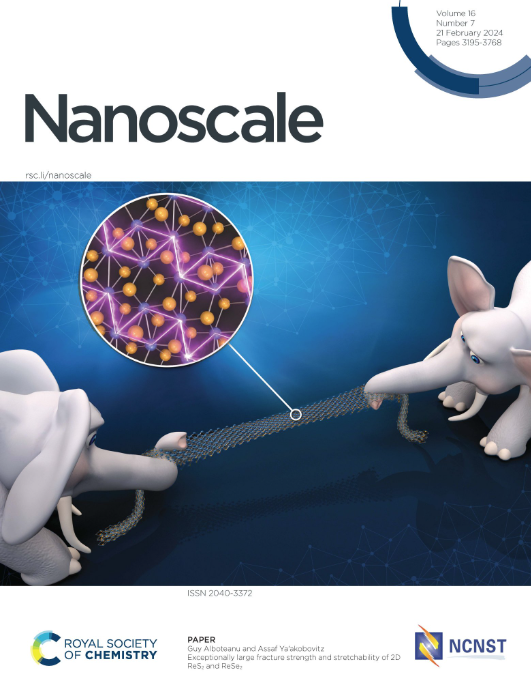识别 SnFe2O4 在氧进化反应中的反应位点:SnII 和 FeIII 在稳定反应中间产物方面的协同效应
IF 5.8
3区 材料科学
Q1 CHEMISTRY, MULTIDISCIPLINARY
引用次数: 0
摘要
在已报道的尖晶铁氧体中,含 p 块金属的 SnFe2O4 鲜有人问津,但它却是一种很有前途的分水电催化剂。本研究的重点是 SnFe2O4 和类似的 Fe3O4 催化氧进化反应(OER)的反应动力学和原子尺度反应机理。用 SnIIOh 取代 SnFe2O4 中的 FeIIOh 位点提高了催化效率,并改善了影响反应动力学的各种内在参数。变温 OER 显示 SnFe2O4 的活化能(Ea)较低,为 28.71 kJ mol-1。实验确定的[OH-]二阶依赖性和氘标记研究中观察到的突出的动力学同位素效应意味着氢氧根离子在速率决定步骤(RDS)中的作用。利用密度泛函理论模拟了 SnFe2O4 和 Fe3O4 (001) 表面的反应机制。反应中间产物的 DFT 模拟自由能图显示了两种铁氧体表面的吸附剂演变机制(AEM),其中 *OOH 的形成是 SnFe2O4 上的速率决定步骤,而 *O 的形成是 Fe3O4 上的速率决定步骤。与其他尖晶石铁氧体的单个金属位独立作用不同,在 SnFe2O4 中,FeIIIOh 和邻近的 SnIIOh 原子之间的协同作用负责稳定 OER 中间产物,与等结构的 Fe3O4 相比,提高了 SnFe2O4 的催化 OER 活性。本文章由计算机程序翻译,如有差异,请以英文原文为准。
Recognizing the Reactive Site of SnFe2O4 for the Oxygen Evolution Reaction: Synergistic Effect of SnII and FeIII in Stabilizing Reaction Intermediates
Among the reported spinel ferrites, the p-block metal containing SnFe2O4 is scarcely explored, but it is a promising water-splitting electrocatalyst. This study focuses on the reaction kinetics and atomic scale insight of the reaction mechanism of oxygen evolution reaction (OER) catalyzed by SnFe2O4 and analogous Fe3O4. The replacement of FeIIOh sites with SnIIOh in SnFe2O4 improves the catalytic efficiency and various intrinsic parameters affecting the reaction kinetics. The variable temperature OER depicts a low activation energy (Ea) of 28.71 kJ mol-1 on SnFe2O4. Experimentally determined second-order dependence on [OH-] and prominent kinetic isotope effect observed during the deuterium labelling study implies the role of hydroxide ion in the rate-determining step (RDS). Using density functional theory, the reaction mechanism on the (001) surface of the SnFe2O4 and Fe3O4 is modelled. The DFT simulated free energy diagram for the reaction intermediates shows an adsorbate evolution mechanism (AEM) on both the ferrite surface where the formation of *OOH is the RDS on SnFe2O4 while *O formation is the RDS on Fe3O4. Contrary to other spinel ferrites, where individual metal sites act independently, in case of SnFe2O4, a synergy between FeIIIOh and the neighbouring SnIIOh atoms is responsible for stabilizing the OER intermediates, enhancing the catalytic OER activity of SnFe2O4 as compared to the isostructural Fe3O4.
求助全文
通过发布文献求助,成功后即可免费获取论文全文。
去求助
来源期刊

Nanoscale
CHEMISTRY, MULTIDISCIPLINARY-NANOSCIENCE & NANOTECHNOLOGY
CiteScore
12.10
自引率
3.00%
发文量
1628
审稿时长
1.6 months
期刊介绍:
Nanoscale is a high-impact international journal, publishing high-quality research across nanoscience and nanotechnology. Nanoscale publishes a full mix of research articles on experimental and theoretical work, including reviews, communications, and full papers.Highly interdisciplinary, this journal appeals to scientists, researchers and professionals interested in nanoscience and nanotechnology, quantum materials and quantum technology, including the areas of physics, chemistry, biology, medicine, materials, energy/environment, information technology, detection science, healthcare and drug discovery, and electronics.
 求助内容:
求助内容: 应助结果提醒方式:
应助结果提醒方式:


